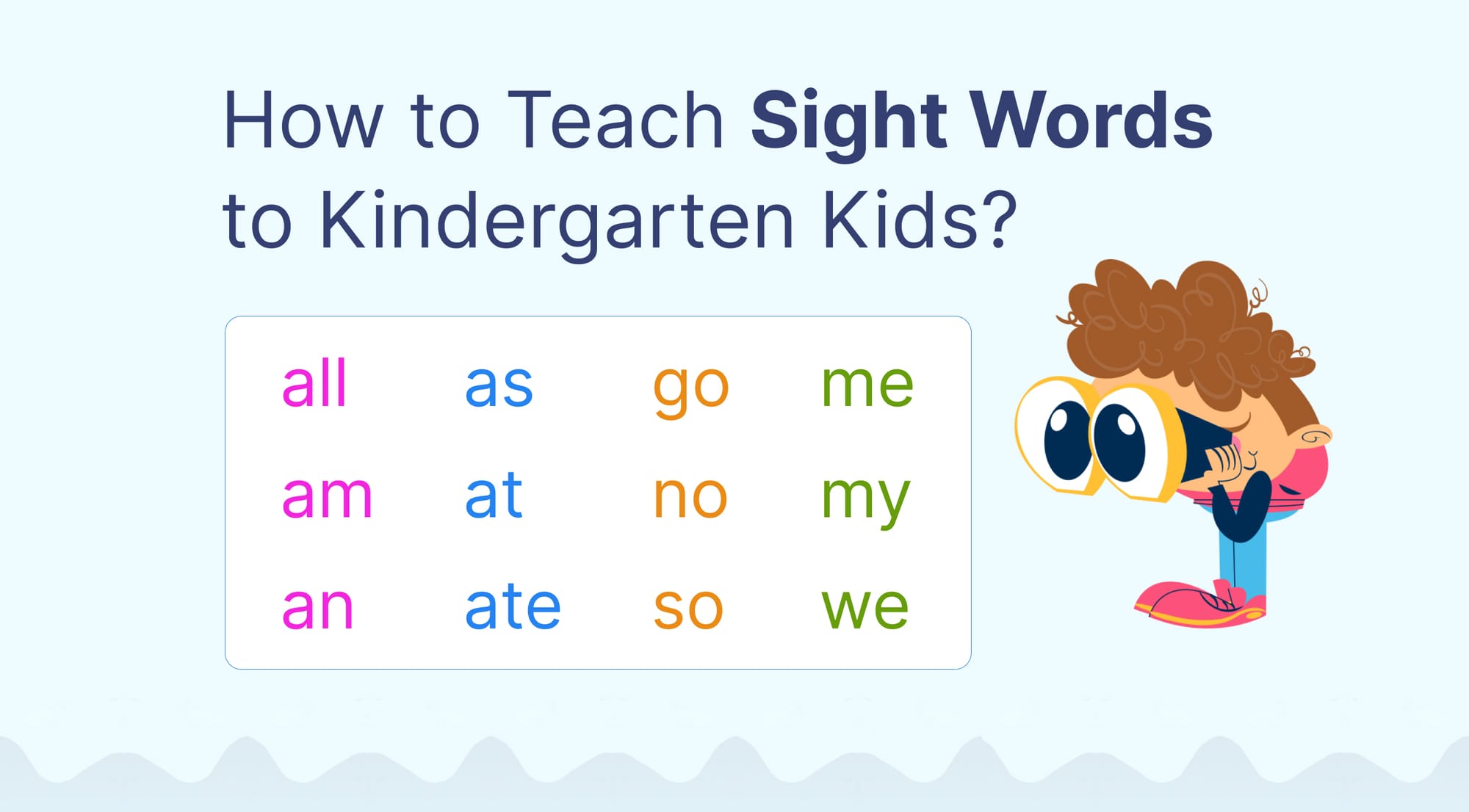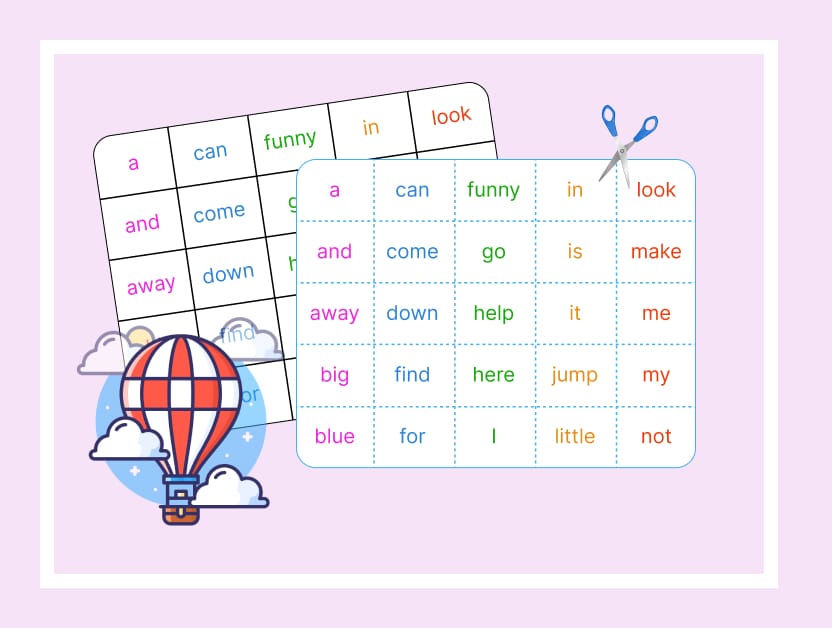How to Teach Sight Words to Kindergarten Kids? (2025)
Searching for fun, practical ways to teach those all-important sight words? We've gathered up the most popular strategies used by teachers in schools & districts all over the country.
When it comes to laying the foundation for reading success, one essential element stands out: Sight Words. Effectively teaching these seemingly small words can set your little ones on the path to becoming confident readers, and foster a love for reading that will last a lifetime.
Like many educators, you're probably wondering what the most effective ways are to teach sight words. While there are numerous popular methods used by teachers nationwide, we've compiled the most effective ones for you right here!
Here are the most effective methods to teach sight words for kindergarten:
- Start With a Small List of Sight Words
- Practice Each Sight Word Individually
- Incorporate Sight Words Into Daily Activities
- Create a Sight Word Wall
- Sight Words Scavenger Hunt - Free Download
- Use Kindergarten Sight Word Worksheets
- Point out Sight Words During Read-aloud Sessions
- Celebrate Their Progress in Mastering Sight Words
What are Sight Words?
Sight words are words that appear most frequently in the English language, such as "I," “the,” “and,” “is,” and “you.” Kids should be able to recognize them instantly without sounding them out. Sight words are sometimes also referred to as high-frequency words, core words, star words, or popcorn words (because they “pop-up” frequently in our reading and writing).
Here are 4 quick facts about Sight Words:
- They appear very often in a text.
- They do not always follow the usual spelling rules.
- They are not easily represented by pictures (for example ‘is’ and ‘the’).
- They are Service Words. They give us meaning and direction.
For the most popular methods on how to teach sight words, read on.

How Many Sight Words Are There?
- The Dolch Word List has 220 sight words and 95 high-frequency nouns mainly used in Pre-K through third grade.
- The Fry Sight Words List includes 1,000 of the most common words in reading materials used in Grades 3-9.
- Together, the Dolch and Fry Word Lists have a combined total of 1042 unique Sight Words.
Source: Dolch Word List, Sight Words
Which Sight Words List to Start With?
The choice of word lists for school curriculum is often determined by the school or district. Using a common list across a school or district provides a big advantage, since it allows teachers to easily share resources and teaching strategies with each other.
Consider the following before choosing one of the sight word lists:
- The Dolch word list is based on Pre-K to grade 3 reading materials, while the Fry word list is based on grade 3-9.
- Both lists have many overlapping words. Whichever list you select, your students will still develop the core vocabulary necessary for early readers.
- The Dolch list was created in 1936 and hasn't been revised since, while the Fry words list was last revised in 1980 and is considered more current.
Some teachers like to start with the Dolch List for their little ones because it's divided by grade, and based on high-frequency words that students in Pre-k through 3rd grade are likely to encounter.
On the other hand, many teachers often prefer the Fry words list because it consists of 1,000 sight words (compared to 220 high-frequency and 95 common nouns found in the Dolch list). Fry's longer list of sight words allows educators to create a program that begins in Kindergarten, and continues through intermediate grades.
Source: thecurriculumcorner
When to Start Teaching Sight Words
Kindergarteners are usually ready to start learning sight words around the age of 5 or 6. Most kindergartners will know between 20 and 100 sight words by the end of the kindergarten year.
Remember that every child is unique, and children develop reading skills at their own pace. If you notice your child trying to sound out simple words or starting to recognize letters, that may be a sign they are ready.
How to teach sight words to kindergarten kids?
Start With a Small List of Sight Words
We want our little ones to build up their confidence and not feel overwhelmed by reading hundreds of sight words early on. Introduce a small, manageable list of sight words. Many teachers like to start with 5 words each week, but keep in mind that some students do better with only 1-2 new words per week. When your students feel confident and reach a certain level of proficiency, move on to the next set of words. This allows students to focus their attention and gradually build confidence as they master each word.
Practice Each Sight Word Individually
Once you've selected a set of sight words, dedicate focused practice sessions to each word individually. Repetition is key 😊 Use flashcards, games, and incorporate specific words into your students' daily activities to reinforce recognition and spelling (more on that in the next tip).
Incorporate Sight Words Into Daily Activities
Helping our little ones learn through daily tasks, may be one of the most efficient ways to help them understand the meaning of different words. It lets us teach "without teaching". Whether it's labeling objects around the classroom, playing word games, or writing grocery lists together, integrating sight words into everyday tasks makes learning more relevant and memorable.
Create a Sight Word Wall
Create a beautiful sight word wall in your home or classroom. One example of this might be to display the Alphabet in large, colorful letters, and each time the students master a new set of words, they can add those words under the correct letter. Encouraging students to interact with the sight word wall regularly, by reading and spelling out the words, also helps them learn the words through spatial memory. Use different colors for each group of words to make your sight word wall even more engaging for the students.
Sight Words Scavenger Hunt - Free Download
Turn sight word practice into an exciting adventure with a scavenger hunt! Hide sight word cards (or sticky notes) around the classroom and challenge your students to find each word. Give them hints to guide their search. Each time the students find a card with a sight word written on it, they need to read and spell the word before sticking it on a clipboard with all of the missing words. This is one sight word activity they are sure to love!

Use Kindergarten Sight Word Worksheets
Choose sight word worksheets that are engaging and effective in reinforcing learning. Look for worksheets that offer a variety of activities, such as tracing, writing, matching, and sentence-building exercises. Seek colorful worksheets with game-like elements to keep your child motivated and focused. You can find free teacher-made sight word worksheets below.
Point out Sight Words During Read-aloud Sessions
We love reading with our students! Make it a point to actively point out sight words in books to draw your students' attention to them. Ask your students to identify and trace sight words with their finger as you read together. Feel free to pause from time to time to discuss the meaning of sight words within the context of the story. This is a very handy method to boost reading comprehension and word recognition skills.
Celebrate Their Progress in Mastering Sight Words
This is a very important step that has a BIG impact on our little readers 😊 Remember to celebrate your students' achievements and progress. A gold star, a sticker, a smile, or even just a high-five is all you need to make their learning that much more memorable and fun! The feeling of achievement goes a long way in building their love for learning.
Conclusion
Teaching sight words to kindergarten kiddos, or young readers of any grade, is an adventure in itself! Use the tools, games, worksheets and tips we covered to boost their confidence and make learning sight words fun and exciting.
As teachers and homeschooling parents come up with new fun and creative ways to teach sight words, we'll be sure to keep you updated!

